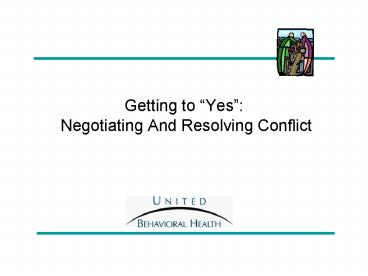Getting to Yes: Negotiating And Resolving Conflict - PowerPoint PPT Presentation
1 / 18
Title:
Getting to Yes: Negotiating And Resolving Conflict
Description:
Getting to Yes. UBH/WS, 3/2002. Managing Conflict (continued) ... Getting to Yes. UBH/WS, 3/2002. Keys to Resolution. Consider changing how you react to the person ... – PowerPoint PPT presentation
Number of Views:1229
Avg rating:3.0/5.0
Title: Getting to Yes: Negotiating And Resolving Conflict
1
Getting to Yes Negotiating And Resolving
Conflict
2
Conflict
- Conflict often occurs when there is an emotional
disagreement between two or more people about
policies, process, activities or outcome.
3
Sources of Conflict
- Competition/rivalry
- Poor communication
- Authority not defined
- Different viewpoints
- Limited resources
- Value/generational/cultural differences
- Aggressive, insecure individuals
4
Costs of Conflict
- Destroys professional relationships
- Creates barriers to individual and organizational
effectiveness - Derails teamwork
5
Costs of Conflict (continued)
- Creates enemies and hidden agendas
- Adds stress to the workplace
- Wastes time, money and resources
- Affects the ability to stay competitive
6
Benefits of Organizational Conflict
- Conflict can
- help increase strength and cohesion
- provide a safety valve function
- help clarify issues and goals
- improve relationships
- foster improved communication
- trigger innovation and creativity
- be a major cause of organizational change
7
Not in My Workplace!
- Remember
- Even the best workplaces will require employees
to deal with conflict resulting from a number of
issues including miscommunication, gossip,
differing agendas and stress.
8
Impact ofPersonalities
- Some personalities add to conflict
- Some create conflict
9
Listening the Key Skill
- Active listening supports teams by
- Focusing conversation
- Providing a clear exchange of information
- Supporting mutual respect
- Providing more options for conflict resolution
10
Becoming a Better Listener
- Concentrate
- Observe
- Respond
- Reflect
- Elicit
- Control
- Notice
11
Issues and Interests
- Issues what
- Interests why
- Examples trust, respect, fairness, value,
recognition, inclusion, security, loyalty
12
Rules Interest-based Resolution
- Listen carefully
- Never think Im good Theyre bad
- Look beneath the issue
- Find common purposes and goals
- Keep emotions in neutral
13
Working as a Team
- Come to agreement on projects
- Mutually identify the goals and outcomes expected
- Dont leave until youve agreed on who, what,
when, where and how
14
Managing Conflict
- Research the motivation behind the action
- Be unconditionally constructive
- Approach the person
- Focus on the behavior, not the person
- Identify what you understand to be the issue
15
Managing Conflict (continued)
- Actively question the other party about solutions
- Choose a solution that meets the needs of both
parties - Discuss an action plan for implementation
- Finalize it
- Check back and evaluate
16
Keys to Resolution
- Consider changing how you react to the person
- Stay flexible
- Check out the facts first
- Act with respect for yourself and others
- Own your feelings I statements
17
Keys to Resolution (continued)
- Focus on solving the problem, not placing blame
- Theres no time like the present
- Change how you react to the person
18
Keep in Mind
- Conflict is neutral
- Despite our best efforts
- You must be the change
- you wish to see.
- - Gandhi
19
(No Transcript)
20
(No Transcript)

